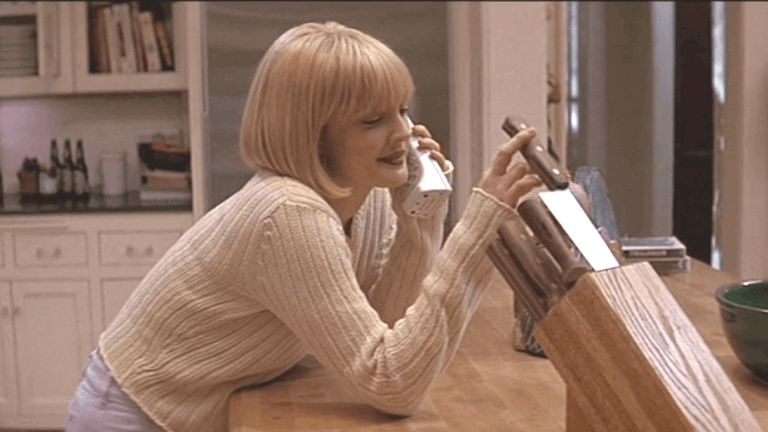How Scream Scared Americans into Buying Caller ID
The original Scream movie was such a phenomenon that Caller ID sales tripled in North America after its release.

There was a time when folks just answered the phone whenever it rang. It sounds like the dark ages now, but as a child of the ‘90s and 2000s, I remember well the days before iPhones and Androids; the years when it would seem strange for a high schooler to carry a cellphone; and I even vaguely recall a world before Scream.
That slasher classic left a deep scar on the zeitgeist when it opened just before Christmas 1996. At a moment when slasher movies were in decline, and horror itself was experiencing something of a fallow period, here was a fresh and exciting chiller that was eager to make audiences cackle as much as shriek. It also began with an opening sequence that became the stuff of infamy: Drew Barrymore, the sweet little girl from E.T., answers the phone on movie night… and is soon cut off by the voice on the other end. Permanently.
The first 10 or so minutes of Scream remain a masterclass of tension, courtesy of director Wes Craven. Here he allows the biggest star of his movie to enter into a lively conversation about “scary movies” with a voice that is both flirtatious and worrying. Provided by voice actor Roger L. Jackson, there is an undercurrent of menace to the caller before things pivot, but the tone is also just playful enough to not be immediately sinister—save for the fact that Casey, Barrymore’s high school character, has no idea who she’s talking to. She just accepts that the voice has dialed a wrong number.
Viewed today, the sequence is both a piece of horror iconography—a movie murder so surprising that it’s sometimes compared to Psycho—as well as a kitschy time capsule left by a bygone age. Why is she talking to a stranger on the phone?! An even better question is why did she even answer that phone in the first place?
The concept of screening your calls—or simply not answering any number you don’t recognize—has become the bane of Scream movie screenwriters in the ensuing decades. The sequels often feel obligated to return to that iconography of a young woman answering a phone and being drawn into a depraved round of movie trivia. So follow-ups have included things like stolen phones, hacked phones, and even cloned phones (the Stab movie within Scream 4 even mockingly introduces the idea of a “Facebook Stalker-Killer”).
But in the 1990s what Barrymore’s character did was perfectly innocuous. After all, almost no one had Caller ID in the mid-1990s. In 2020, Barrymore even brought renewed attention to this by saying on CBS, “Did you know Caller ID use tripled after the premiere of Scream?”
Indeed, prior to the release of the ’96 slasher, Caller ID was a relatively new technology, at least in terms of mass commercial viability. The concept was invented in 1968 when Greek inventor Theodore Paraskevakos was working as a communications engineer in Athens. At the time, Paraskevakos was employed by a European IT company, and he came upon the idea of developing a system that would automatically identify a telephone caller to a call recipient. He would patent the invention a year later, but it wasn’t until 1971 that he began experimenting with it in the U.S. in select regional communities, beginning with Leesburg, Alabama, a town with a population of around a thousand people.
Over the next decade-plus Paraskevakos would refine the technology and develop patents for it all over the world, but it did not become commercially available in the U.S. until December 1988 when BellSouth made the service available to customers in Memphis, Tennessee. This was only a few years removed from Bell Atlantic (known today as Verizon) still conducting their own market trials in New Jersey. Eventually, BellSouth became the first to deploy Caller ID as a service across nine states. But even that rollout wasn’t complete until 1993. And it was such a revolutionary idea it received significant political and media scrutiny.
“A SPECIAL telephone service used by 30,000 customers in New Jersey to view callers’ phone numbers without having to pick up the receiver is part of a national debate over privacy,” The New York Times reported with an air of ethical concern in 1990. “… But as the service becomes more widely available, lawmakers are taking steps to protect the privacy rights of callers, which they fear the service violates.”
So in 1996, the idea of thinking you might even know who is on the other end of a phone call (at least without letting it go to voicemail if you had such an external device set up) was still relatively alien. Most folks just answered the phone. It was the scenario that created a fertile ground for crank calls, telemarketing during its most booming years… and Ghostface.
One of the things that’s so scary about the ’96 movie’s opening is how real it feels. Barrymore’s Casey Becker is a young, intelligent woman who’s seen all the scary movies that Scream’s target audience would also be aware of. She is media literate enough to deconstruct the misogyny of most slashers while still crediting Halloween (1978) and A Nightmare on Elm Street (1984) as a cut above. She’s preparing popcorn after likely making a stop at the local Blockbuster, and she’s waiting for her boyfriend to show up when a stranger calls. As they were wont to do in the ‘90s.
So she answers the phone… and she dies brutally for it, with her mother hearing her last gasps over the landline after Ghostface has removed her larynx.
Watched 27 years later, this difference in perceived “normal” behavior is a glimpse into the past. Other curios include the fact that the sheriff’s department of the film’s small town immediately become suspicious of Billy Loomis (Skeet Ulrich) because the lad was found near the scene of another Ghostface phone call/attack while carrying a cellphone. What kind of teenager would own a cellphone? The idea of a youth carrying the tool of adult yuppies was treated as a red flag for evil!
On the eve of Scream 6’s release, these elements from the original play almost as camp to the modern eye. But the original movie seems to have also played a role, if only marginally, in shaping that future.
After Scream’s release, the idea of getting Caller ID became incredibly popular. And speaking anecdotally, I can recall that buying an external box that screened all calls still seemed like a luxury that our family never bought into. However, friends and I became obsessed with “*69,” the eventual U.S. telecom service that would tell you the phone number of the last caller that dialed your landline. (Assuming of course that the caller did not use “*67” before dialing, which would block their number.)
Even Scream 2 (1997), which was released 12 months later, commented on these changing trends when the film’s returning protagonist Sidney Prescott (Neve Campbell) is introduced in her college dorm room as screening all her calls with Caller ID. When a crank caller tries to scare her in the morning, she reads him back his name and phone number and threatens to call the cops.
Of course everything fades, and in 2023 Ghostface has to think outside the box if he wants to get through to his victims. But perhaps he has only himself to blame for that after he scared the hell out of everyone back in the ‘90s.
